North Entrance Window
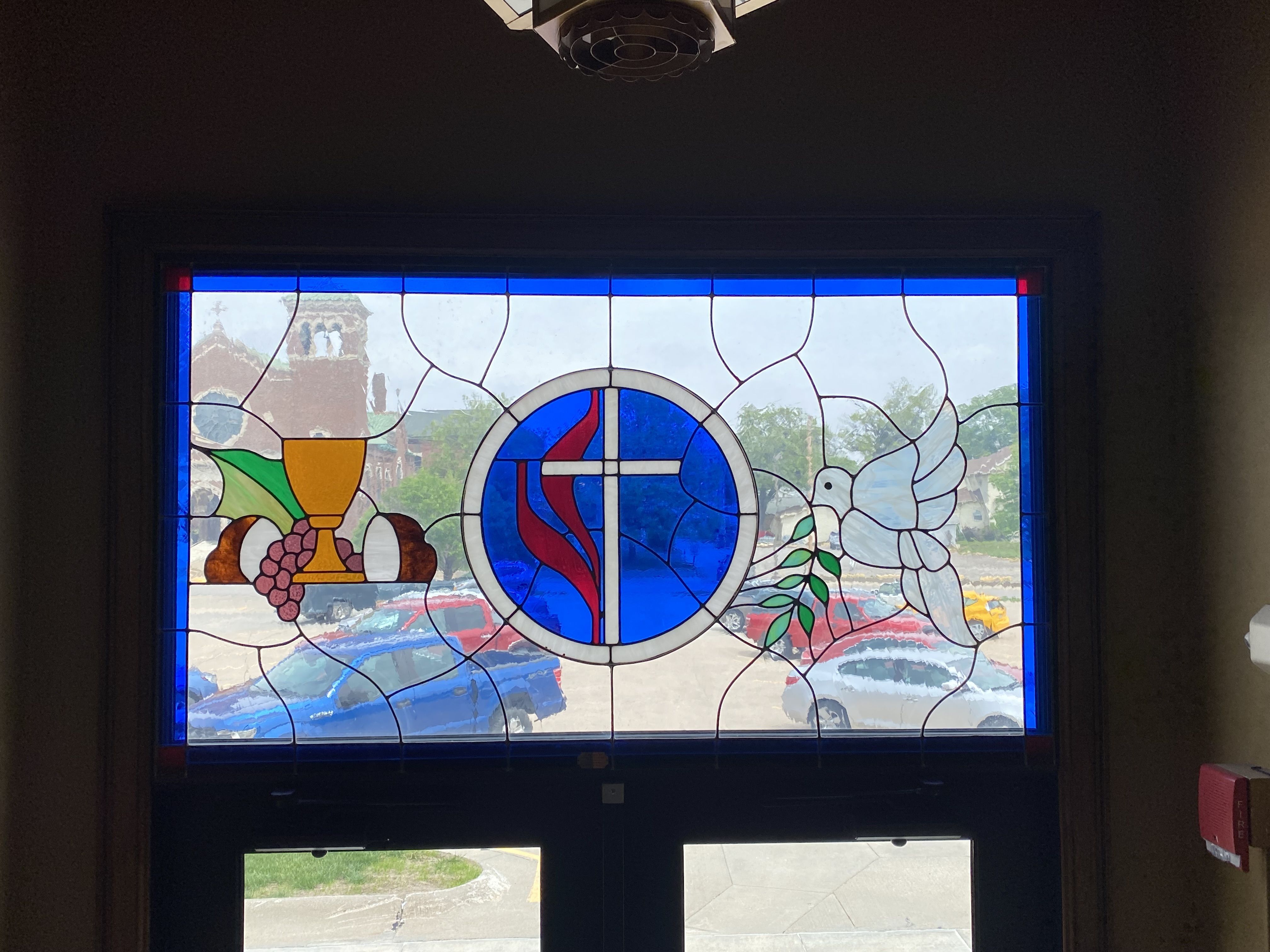
This window was installed in 1990, incorporating the symbols of modern-day Methodism with the symbols of the past.
The central theme is the symbol of United Methodism, the cross and the flame. This became the symbol of the United Methodist Church at the union of the Evangelical United Brethren and the Methodist Churches in 1968. The cross represents God's love for us shown by Jesus Christ; the flame represents the Holy Spirit; and both are within the circle which represents divinity and eternal life.
On the right is a dove with an olive branch, the symbol of peace. On the left are the bread and wine, the symbols of Holy Communion, representing Christ's body and blood.
The Narthex
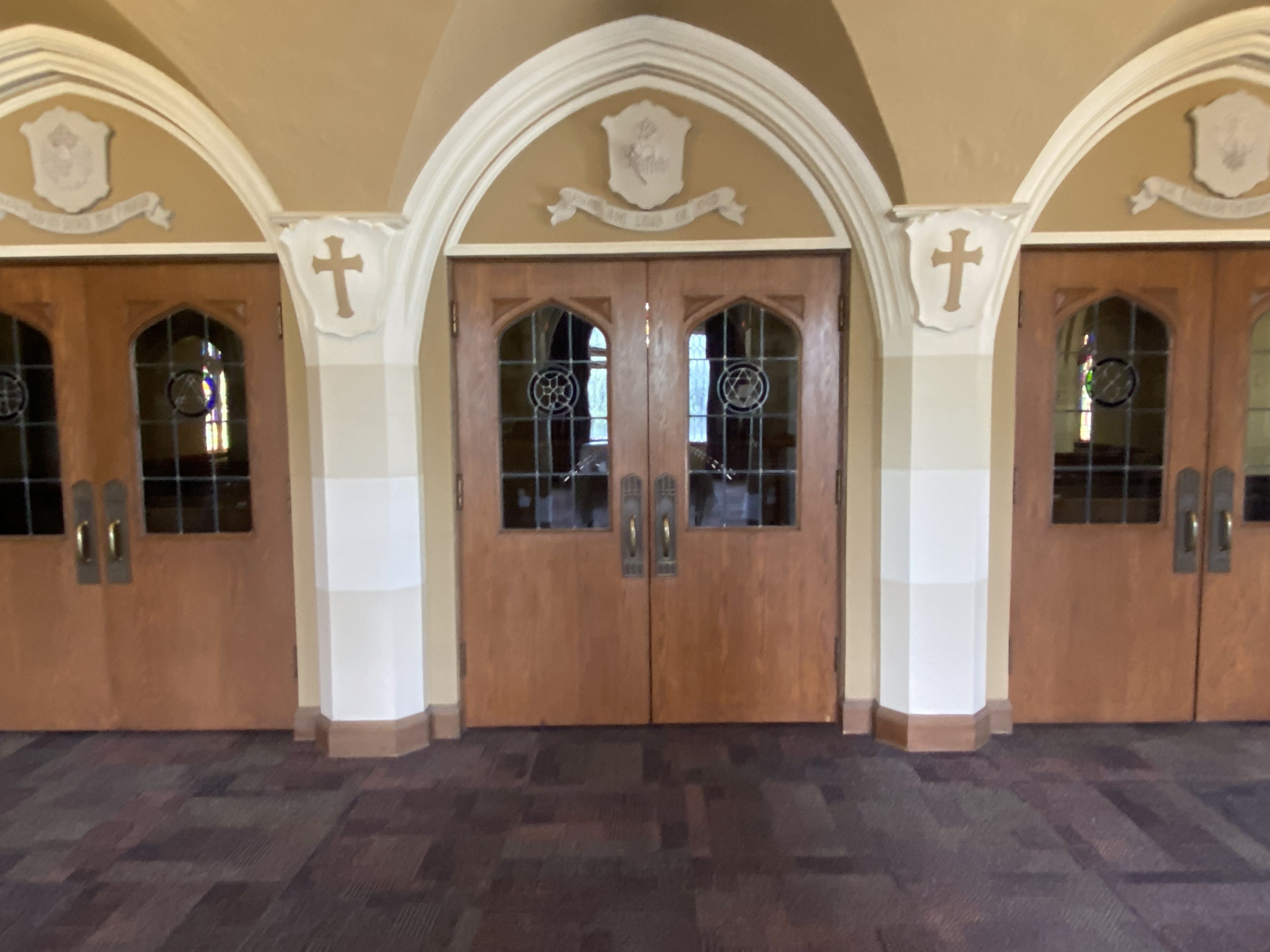
A narthex, defined as any church vestibule, was originally a porch, a place for penitents and for those who were not admitted to the church. Designed as a place to prepare for worship, it leads to the sanctuary.
The symbols in plaster above the doors leading to the sanctuary are:
THE HAND, the symbol of God
THE LAMB, THE CROSS AND THE GATE, symbolizing Christ as our Saviour; and
THE DOVE, the symbol for the Holy Spirit.
The shield with a cross on it is found in many places. Remember St. Paul's words in Ephesians 6:16, "Above all, taking the shield of faith with which you can quench all the flaming darts of the evil one."
The Great Window
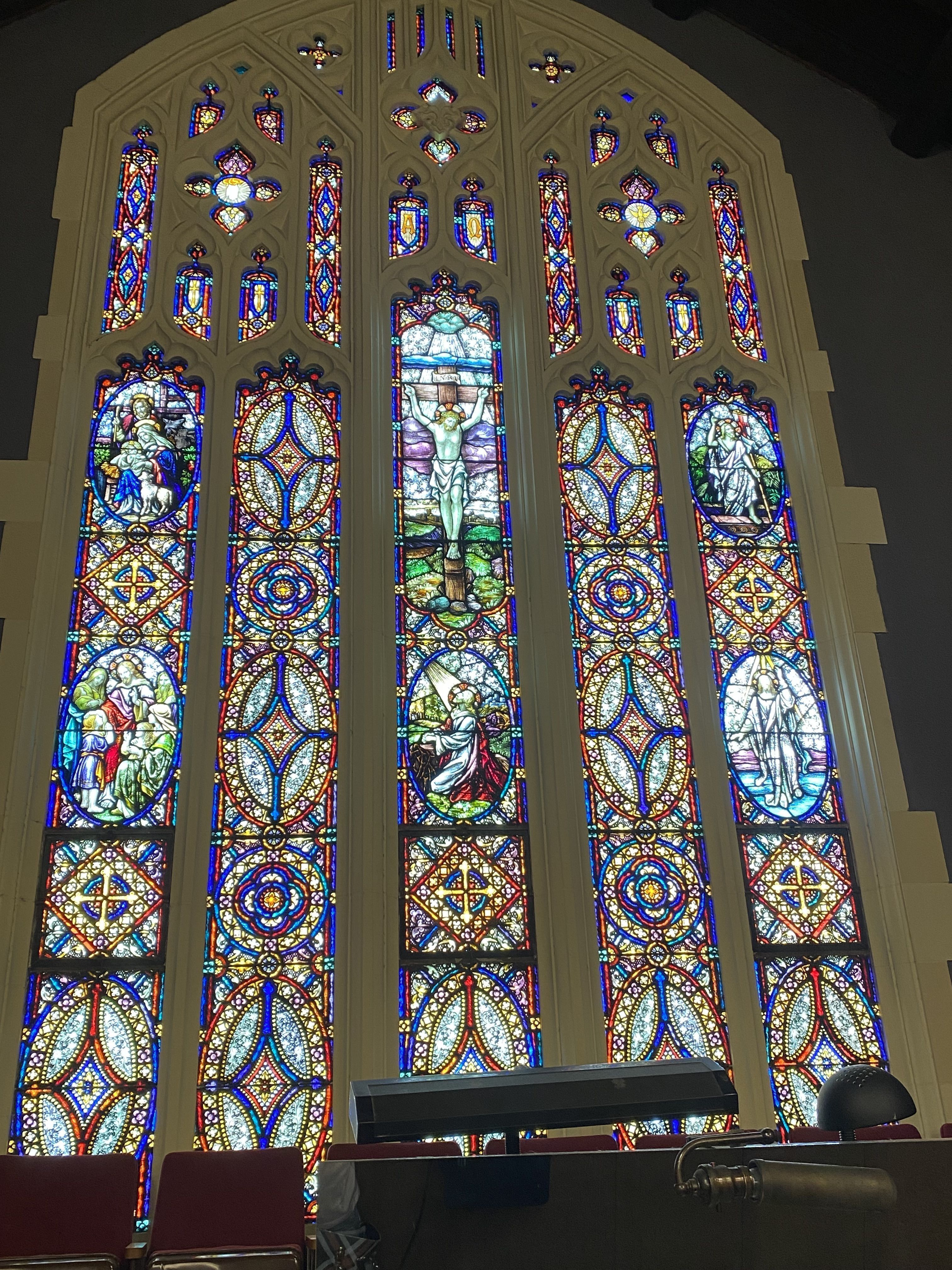
Dominating the Sanctuary is the Great Window. Christ is the subject. His cross is in the central and most prominant place.
At the top of the window are three Christian symbols in small medallions. The hand signifies God reaching down to us. The two letters with which Greek alphabet begins and ends, Alpha and Omega, signify God, the beginning and ending of all things as in Revelation 1:8. The dove represents God's Holy spirit coming down to waiting people.
The three long picture panels tell the life of Jesus. At the upper left is his birth and at the lower left is Jesus with the children. The lower center window is Christ in Gethsemane on the night before his trial. Upper center is Jesus on the cross. At the upper right Jesus is coming forth from the tomb. At the lower right Jesus is ascending to Heaven.
Another interpretation of these six pictures groups them horizontally, left to right: The pictures at the top of each panel represent the three most meaningful days of Christendom and primary doctrines:
1. Christmas, the Divinity of Christ;
2. Good Friday, the Atonement;
3. Easter, the Resurrection.
The pictures at the bottom of each panel represent three experiences of Christ's life which bear definite relationship to us and which have molded the thought of Christianity.
1. Christ's example in dealing with children has lifted the child to a supreme place in our thought and care;
2. Christ's experience in the Garden has given to Christianity the highest concept of prayer;
3. The Ascension, together with Christ's promise of the Comforter (the Holy Spirit), brings the recognition of the ever-present Christ in the world today.
Windows on the Sides of the Sanctuary
There are three double windows on each side of the sanctuary which have symbols representing the Apostles. Most of these windows have in them the means of each Apostle's death. All but John were killed for their faith. There is no window for Thaddeus, one of the original twelve.
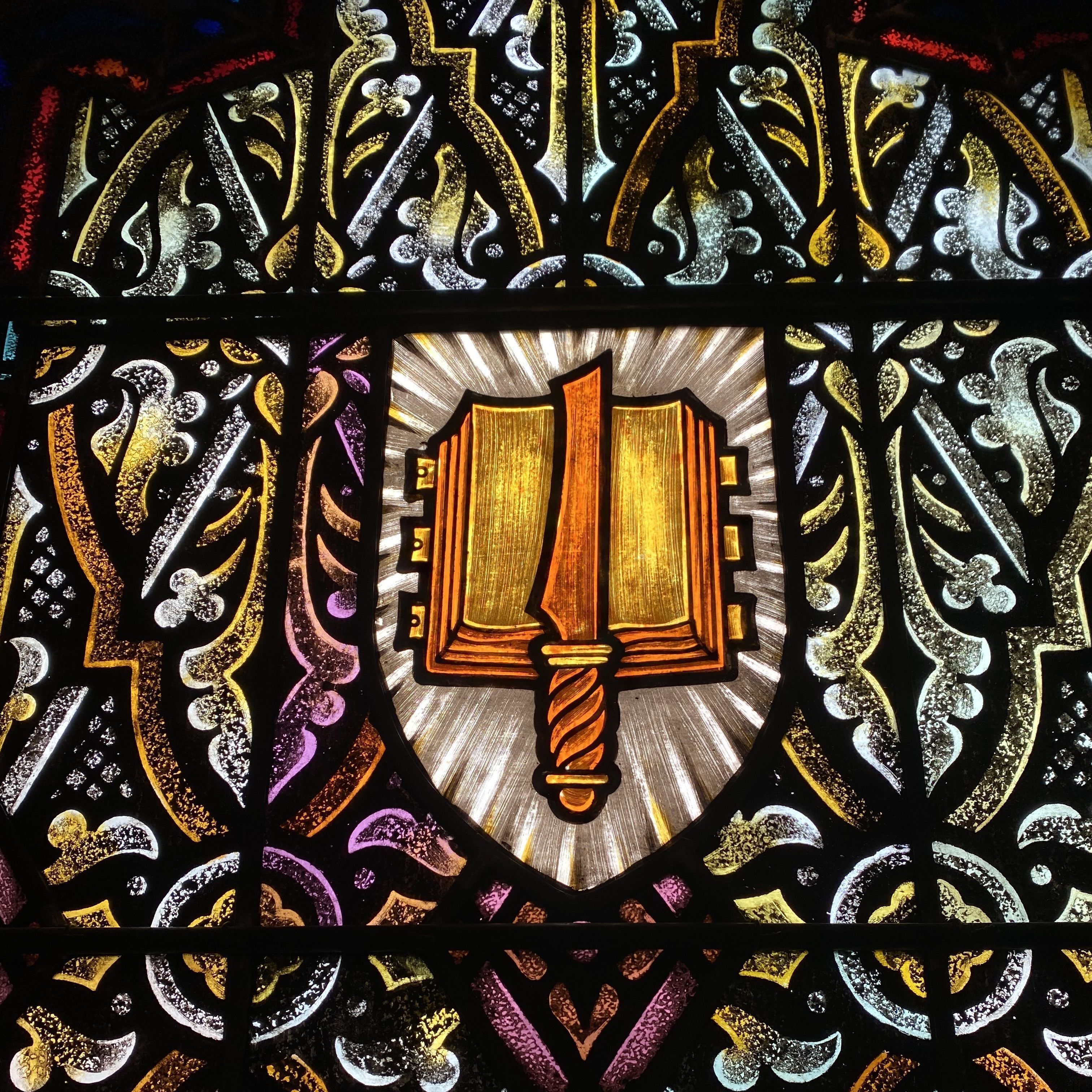
Starting at the left rear of the sanctuary, the first of these windows has a book and a knife, the book from with Bartholomew (also known as Nathanial) preached and the knife that was the means of his death by beheading.
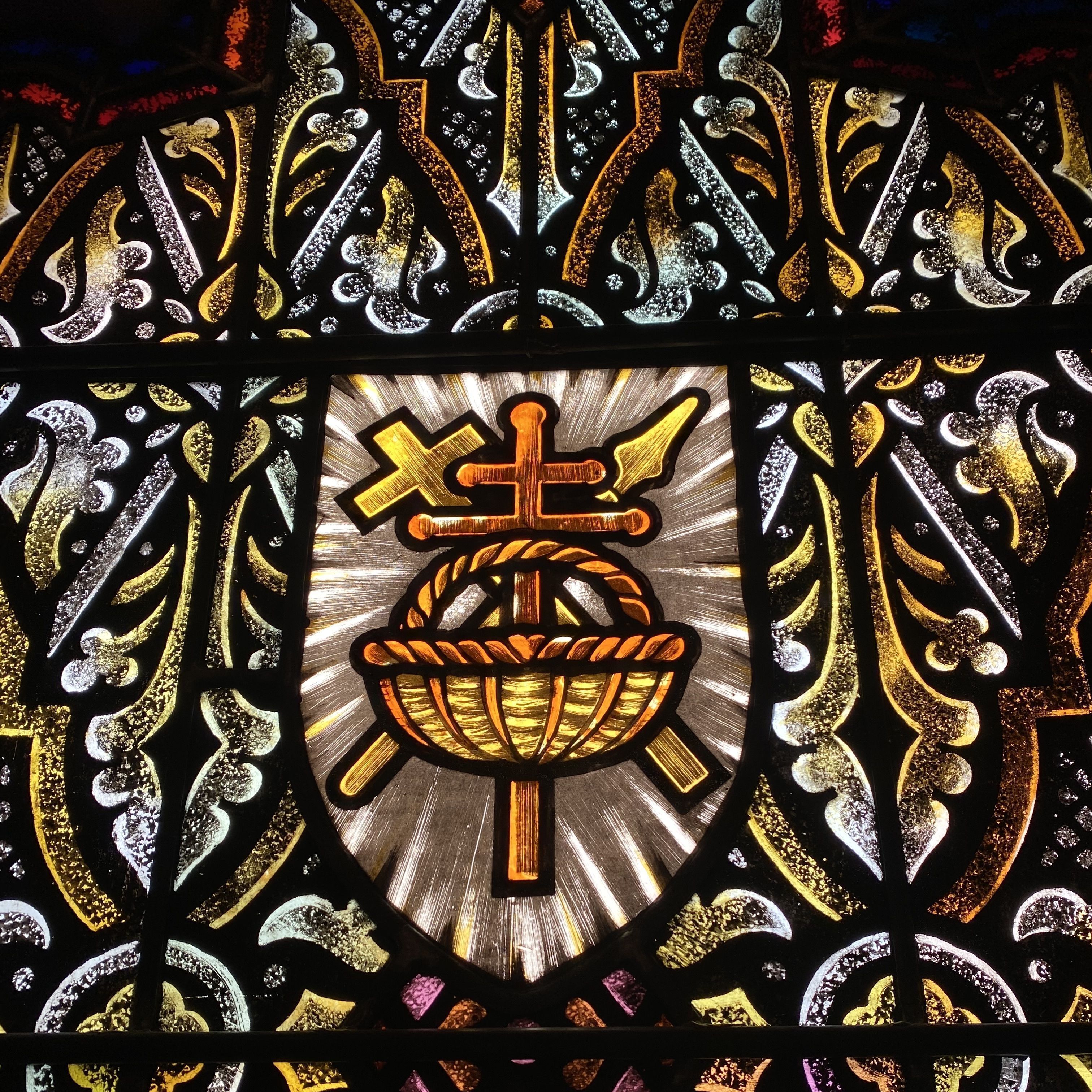
Philip helped feed the 5000 and is represented by the basket. He met death by crucifixion and being pierced with a spear.
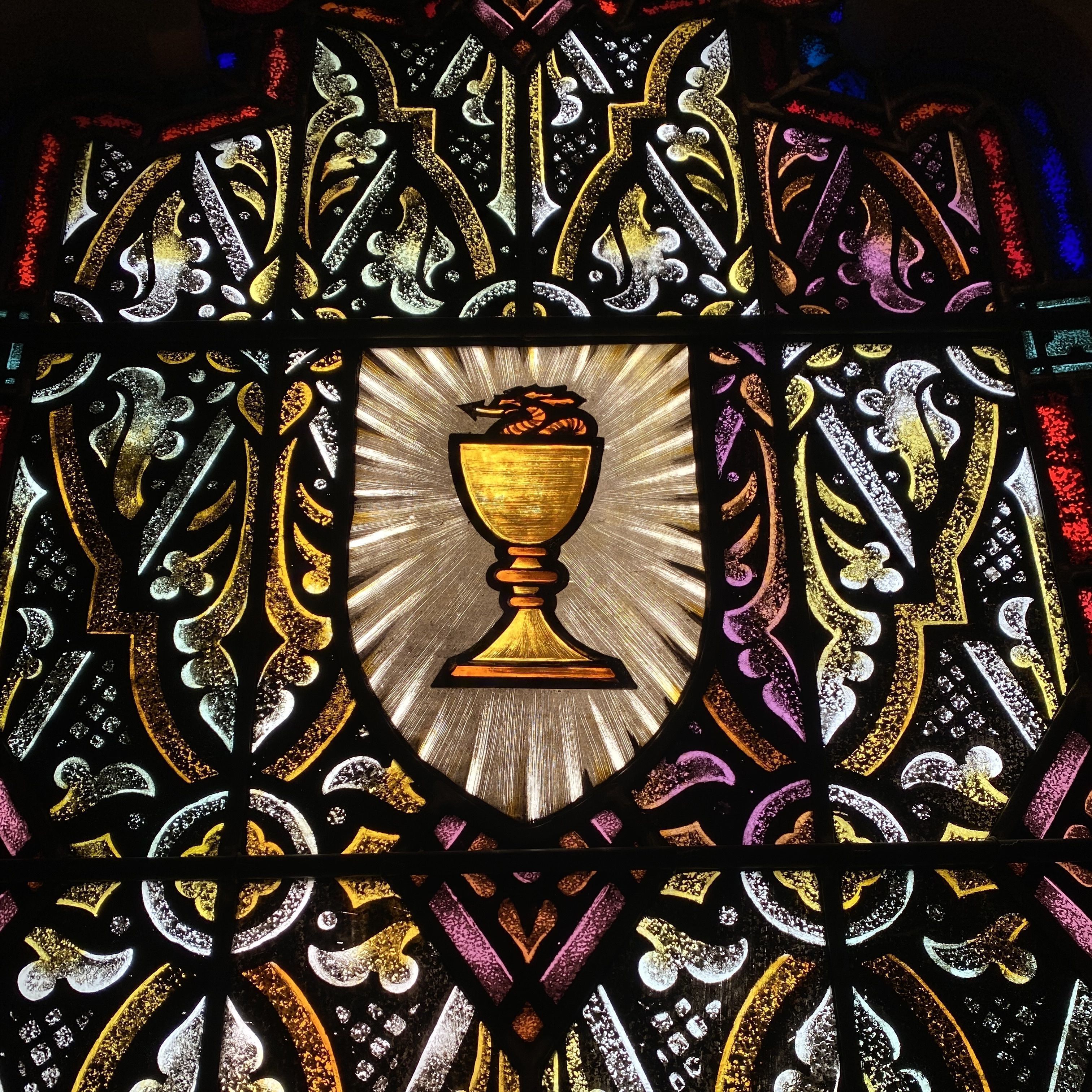
The next window on the right honors John the beloved disciple. Tradition tells us John was once challenged by one of the Priests of Diana to drink a draft of poison and that Satan in the form of a winged serpent arose from the cup and flew away. Hence the cup and the coiled serpent.
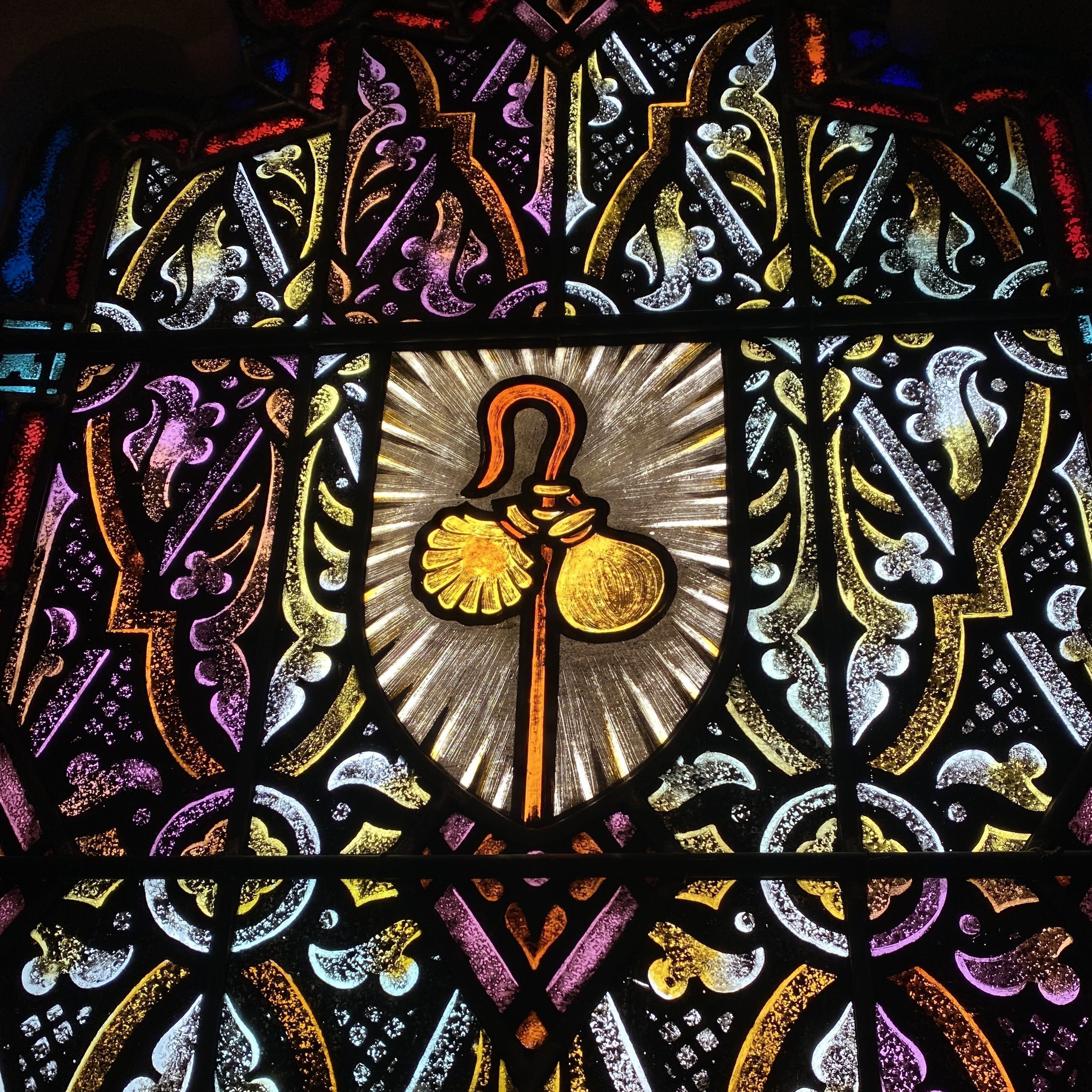
Paired with this window is the one representing John's brother James. It has in it the seashell (with which Apostles were said to have baptized people by pouring water on them), the bag and the staff of a man going on a long journey.
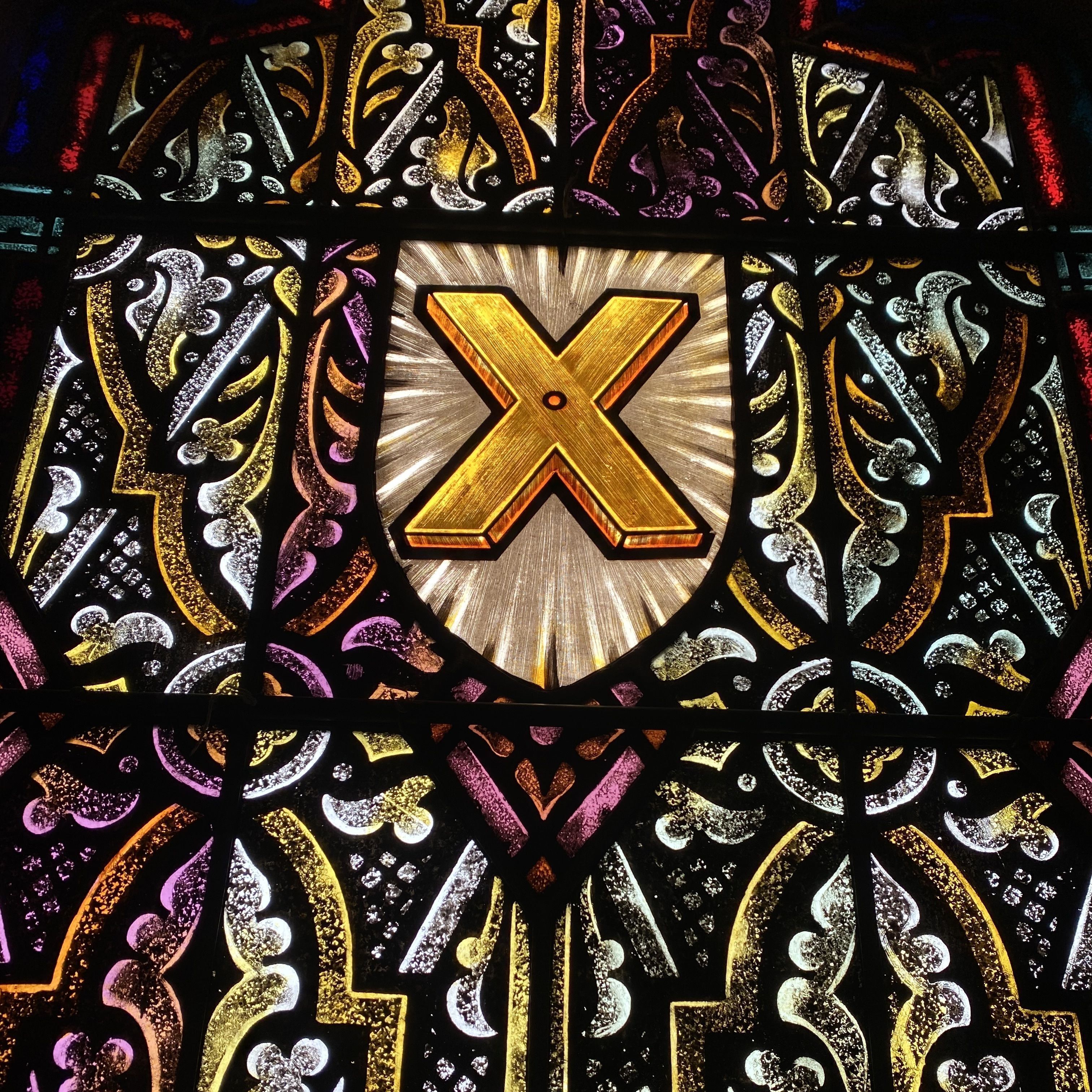
The next pair are also brothers, Andrew and Peter. The symbol for Andrew is the Greek cross. Tradition tells us that he was crucified by being bound to the cross.
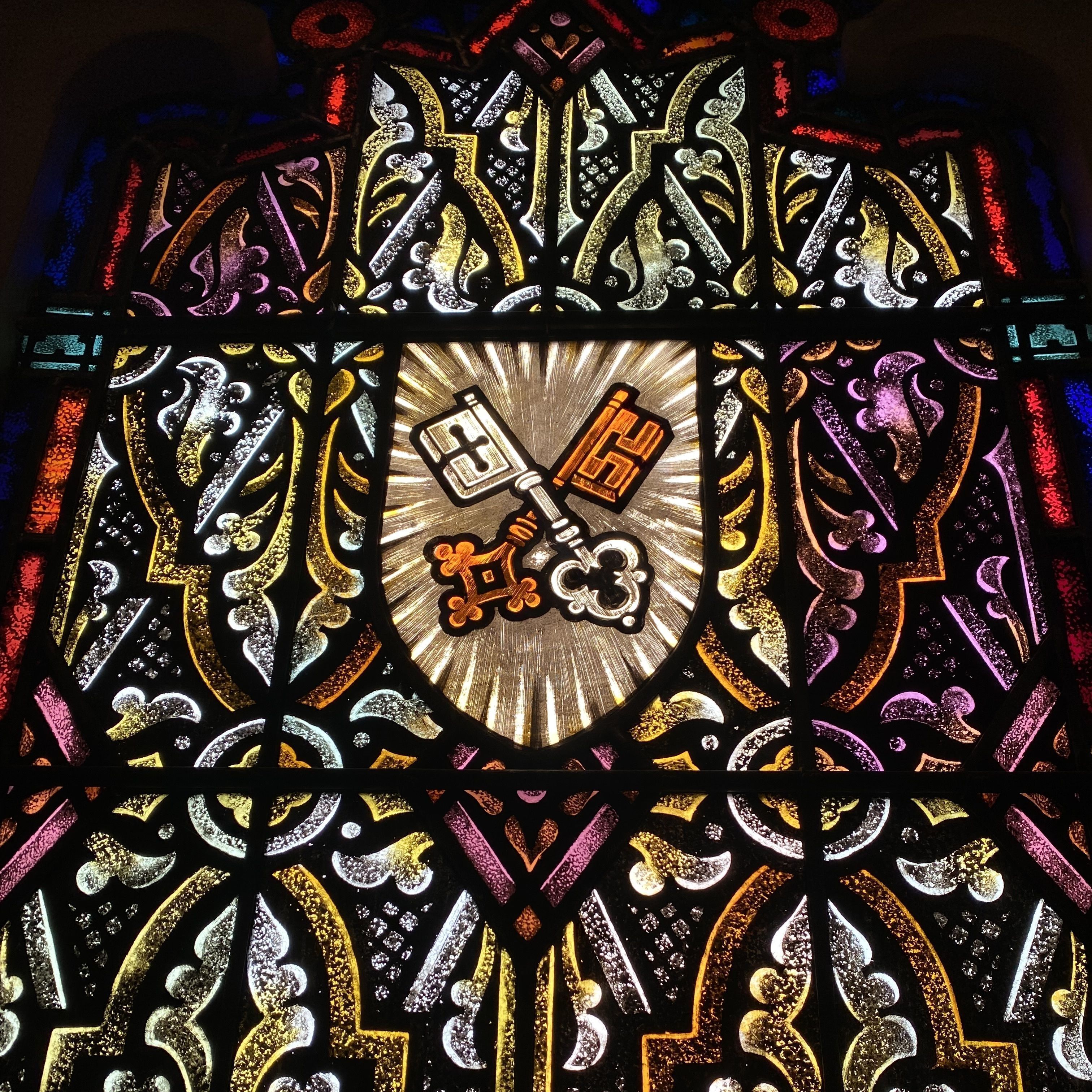
The window representing Peter has a pair of keys symbolizing the keys of the kingdom of heaven given to him by Christ.
On the right side of the congregation, the three center windows continue the story of the Apostles.
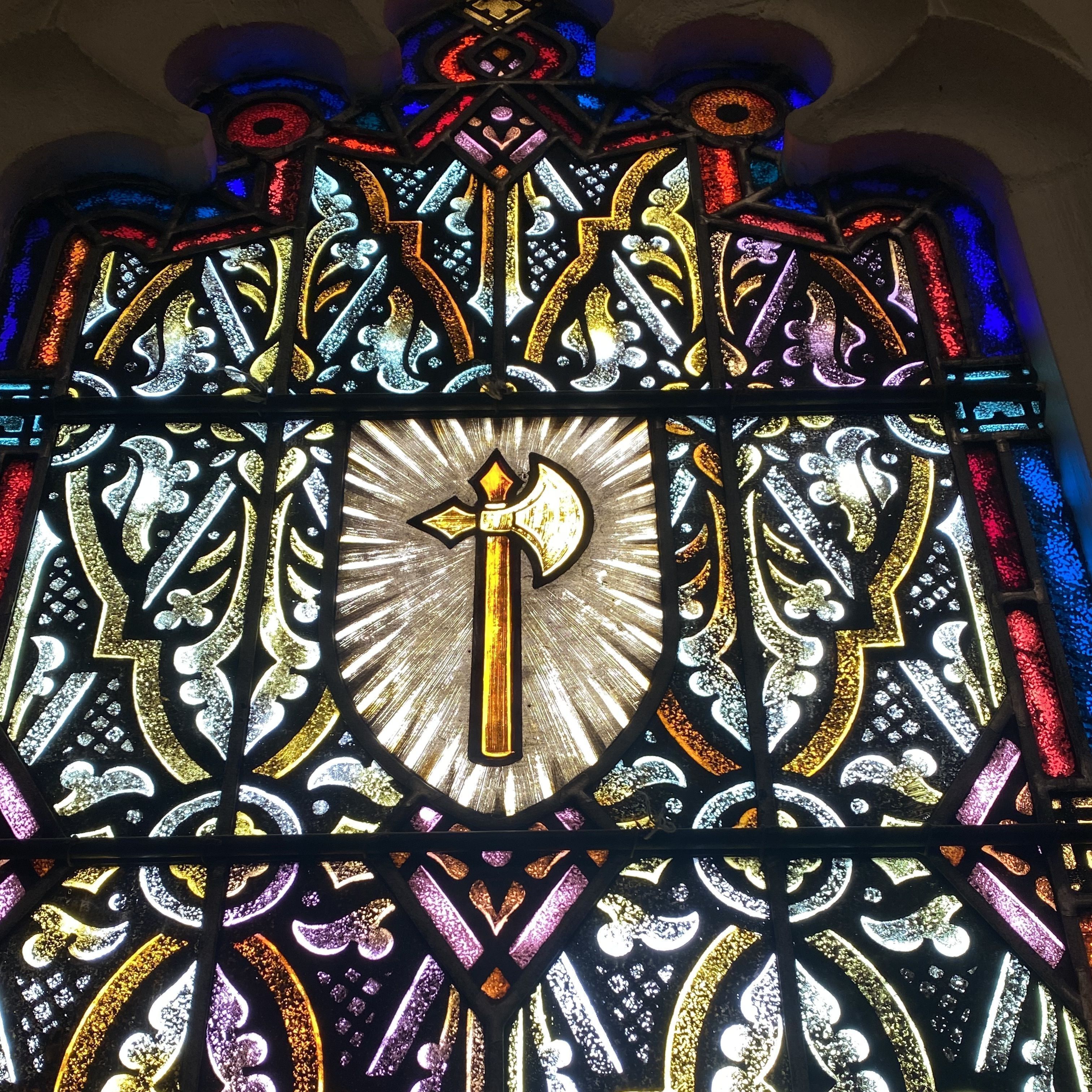
From the front (the third window from the west end on the north side) is a symbol of Matthew who was killed by a battle-ax.
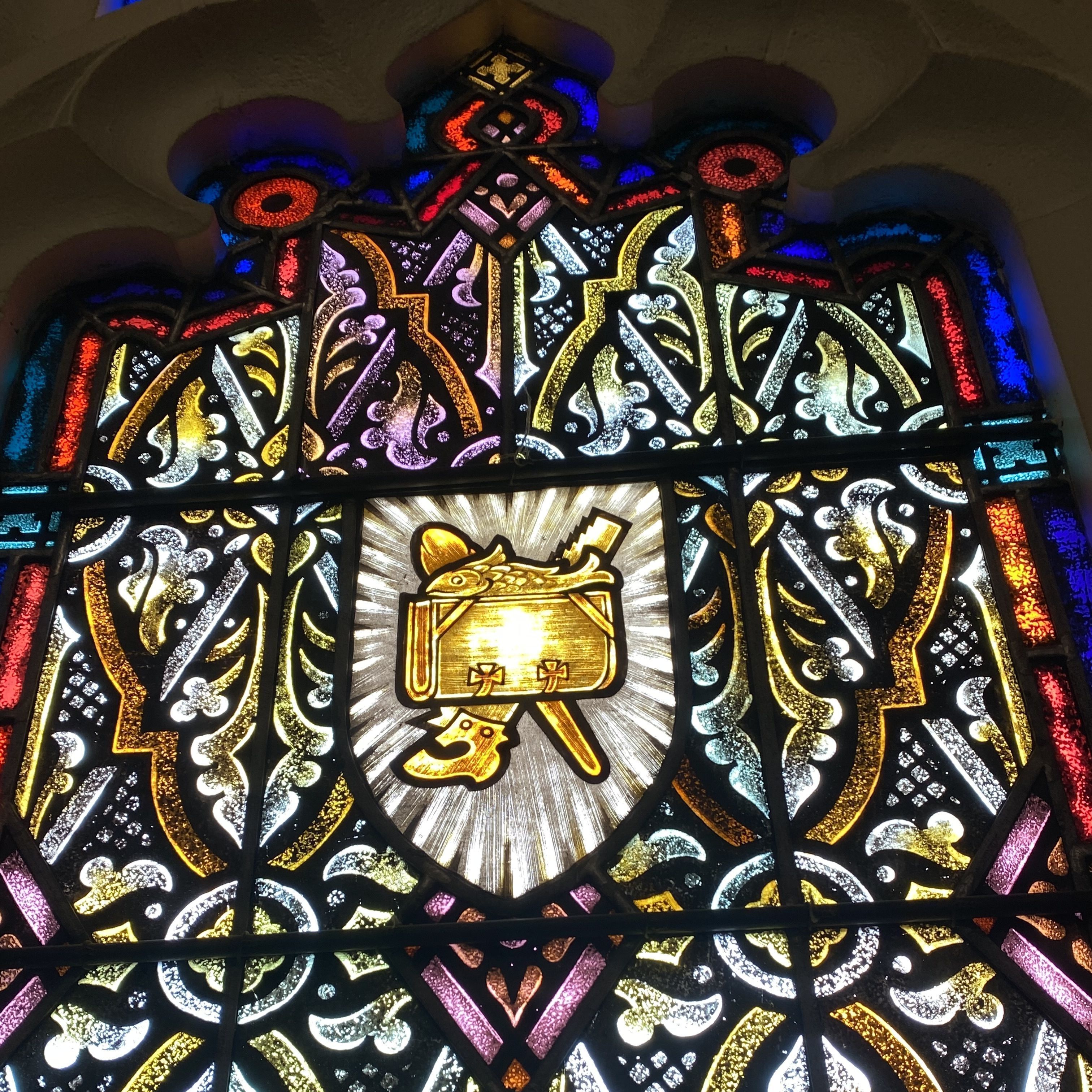
The next window, with a book, fish, and a saw, represents Simon the Zealot. The book is the sign of his authority to preach; the fish, the sign of his trade, and the saw, the instrument of his death.
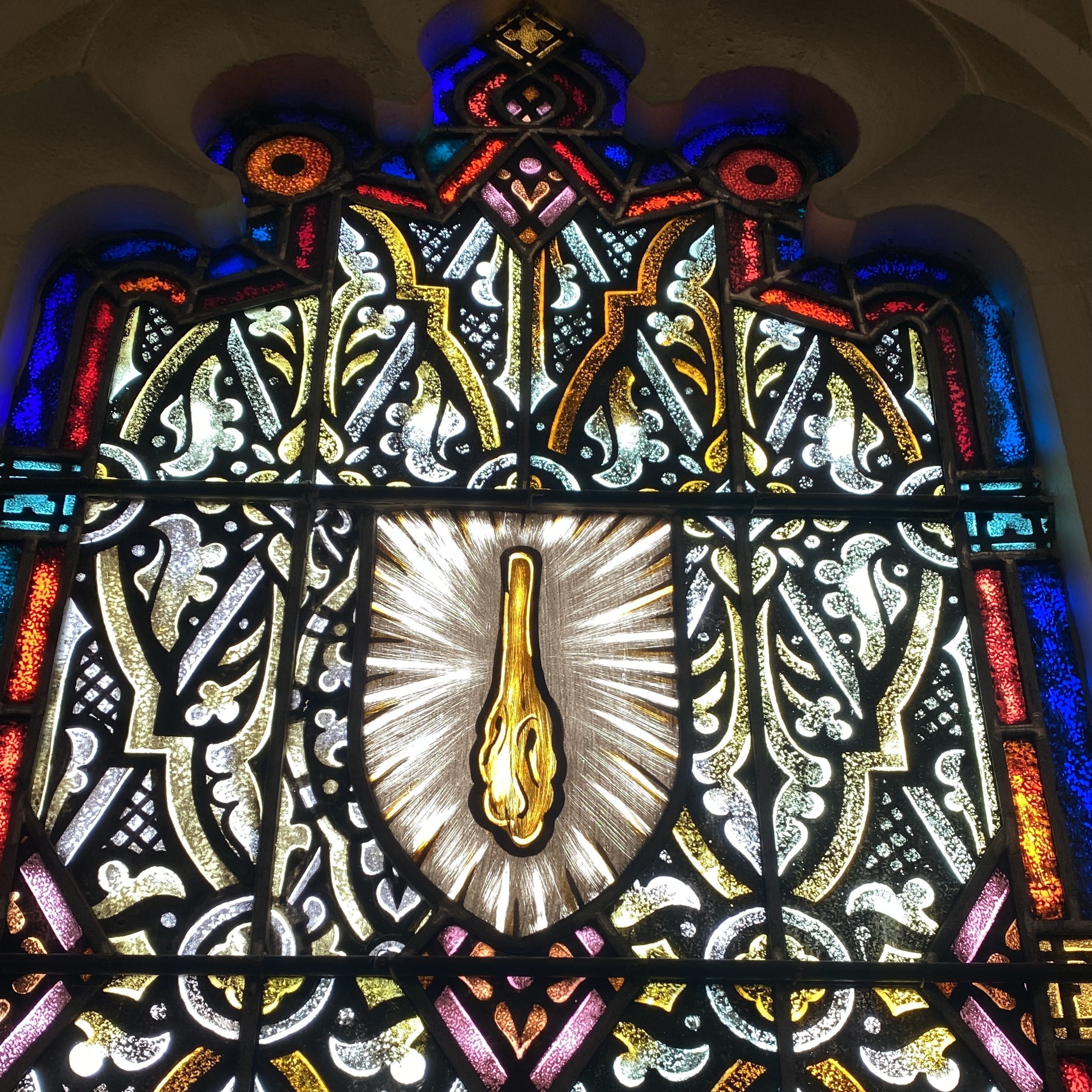
The center window shows the club or dyer's pole by which James the Less was put to death by clubbing.
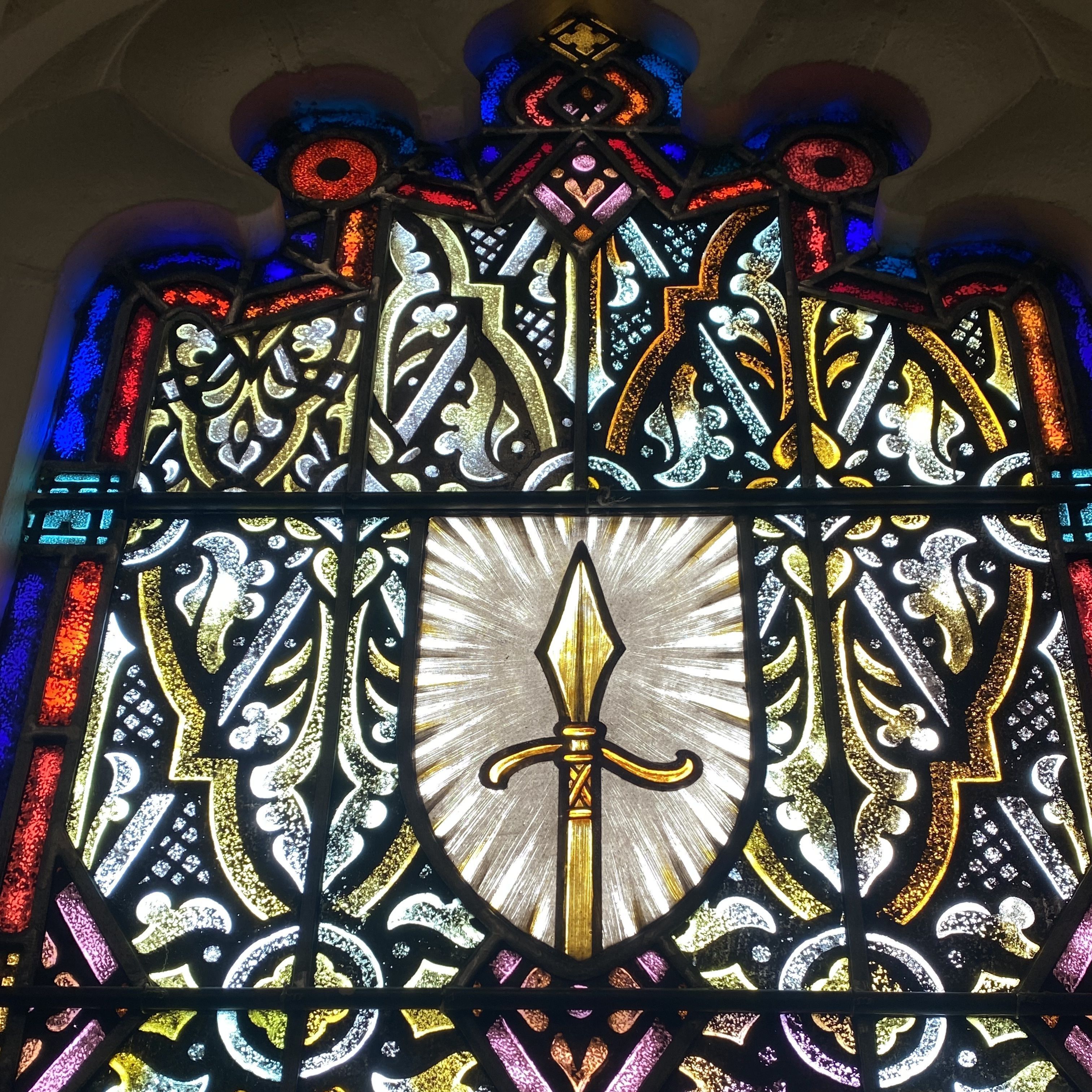
Mathias was the Apostle chosen to replace Judas. The spear was the instrument of his martyrdom.
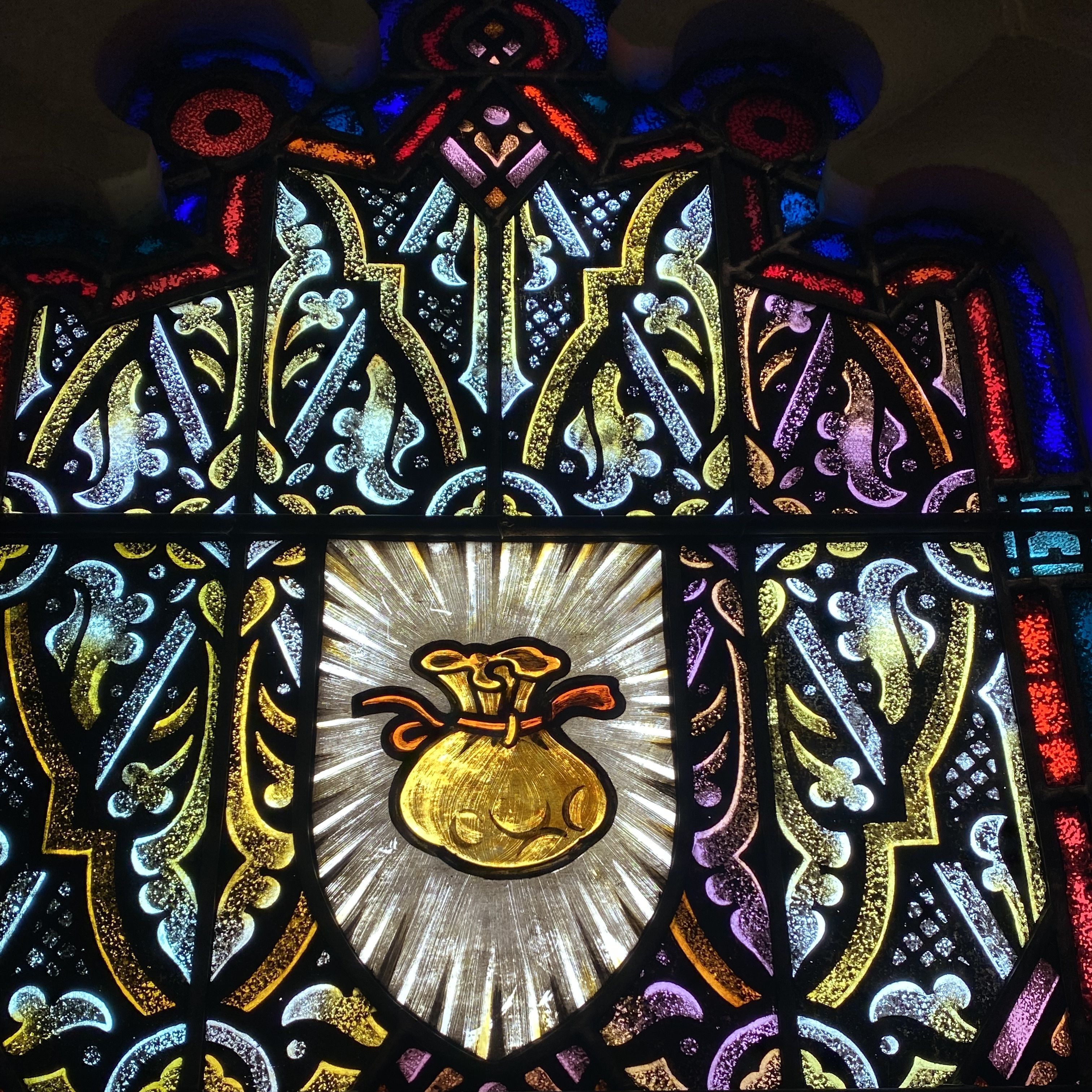
In the next window the money bag tied with a rope reminds us of Judas, who went out and hanged himself after betraying Jesus.
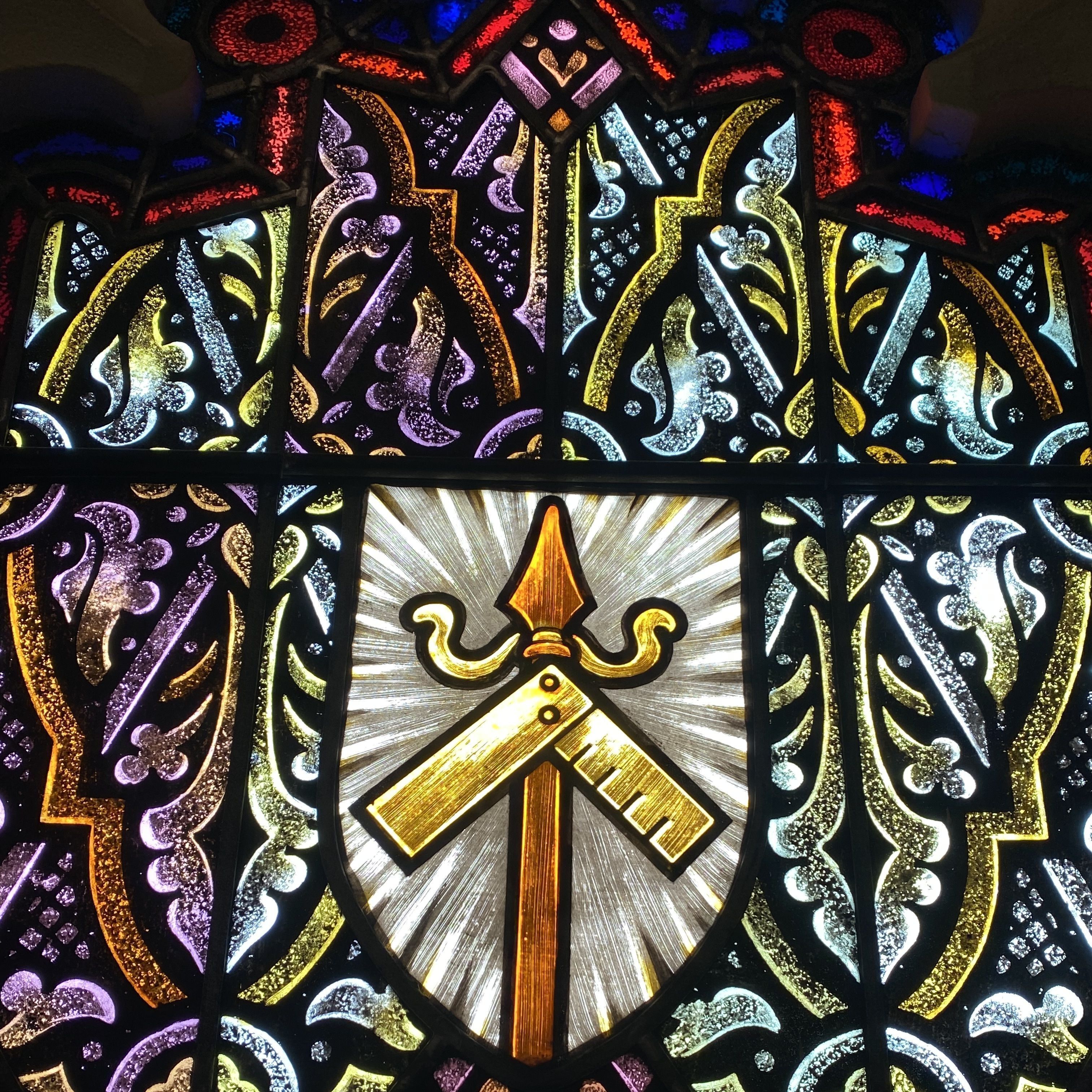
The square and spear are for Thomas, a carpenter, put to death by a spear.
The Windows At The Back
Looking on towards the back of the church on the North side is a pair of Windows dedicated to John the Baptist and Isaiah the Prophet
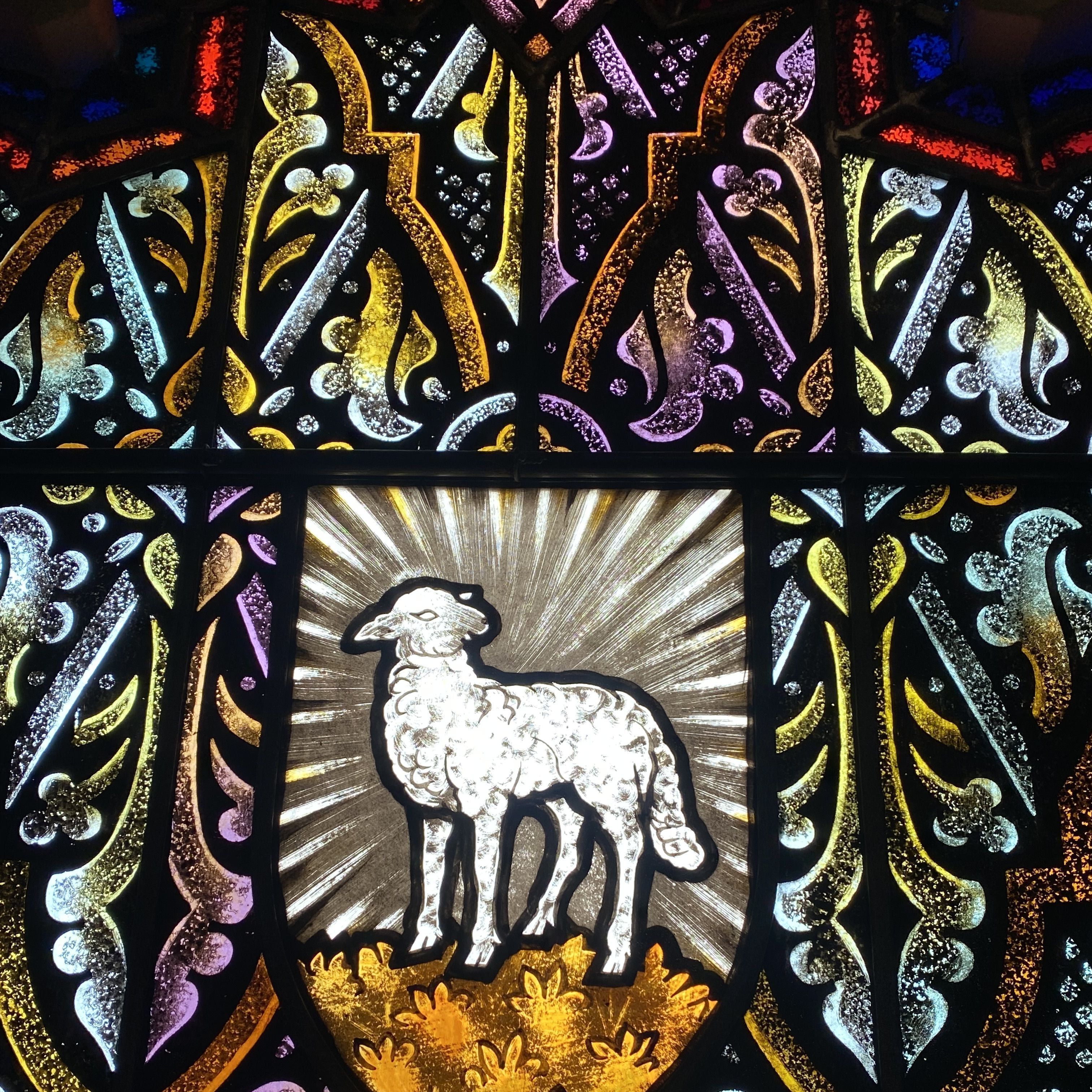
The lamb symbolized John the Baptist who said of Jesus, "Behold, the Lamb of God."
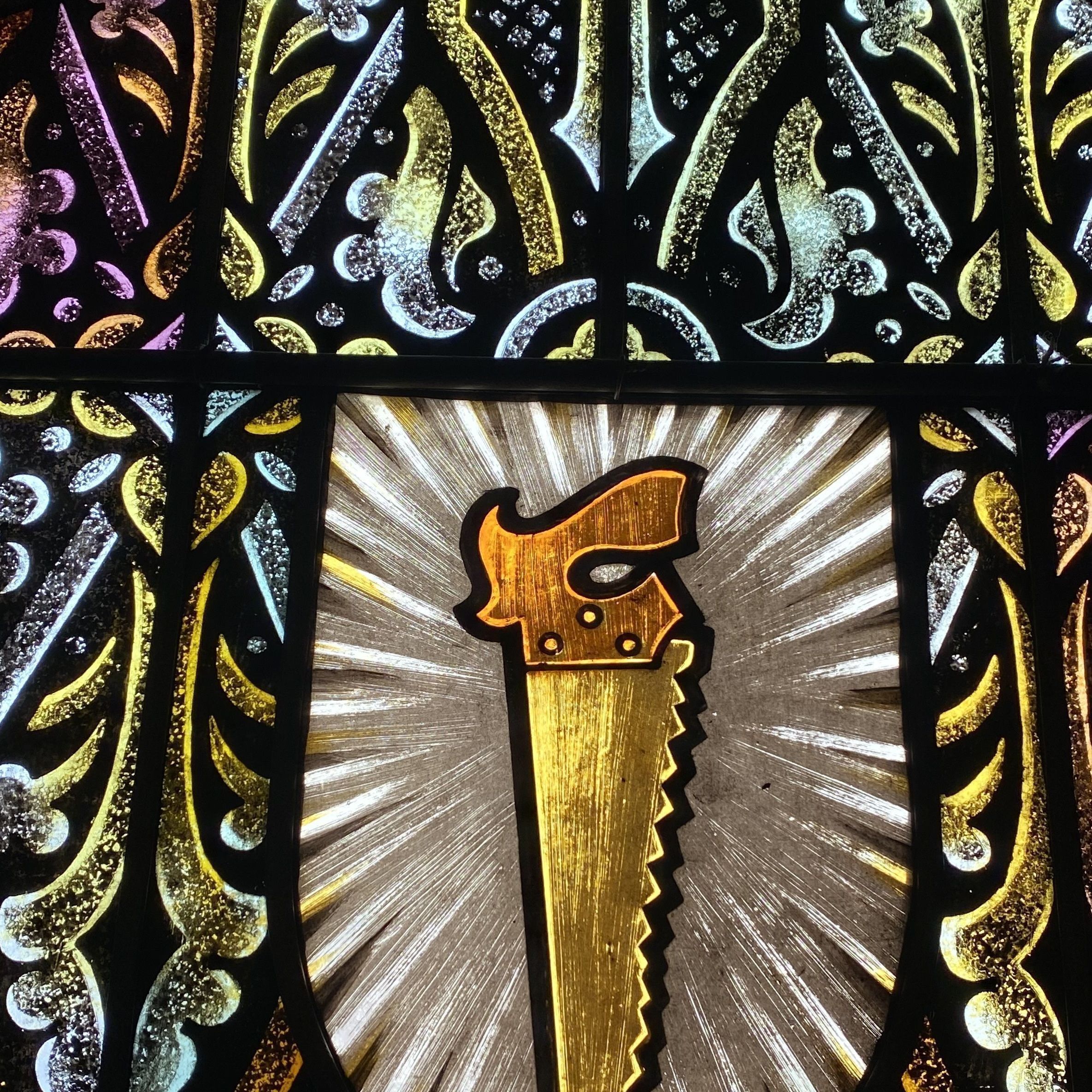
The saw....The tool with which Isaiah met his death.
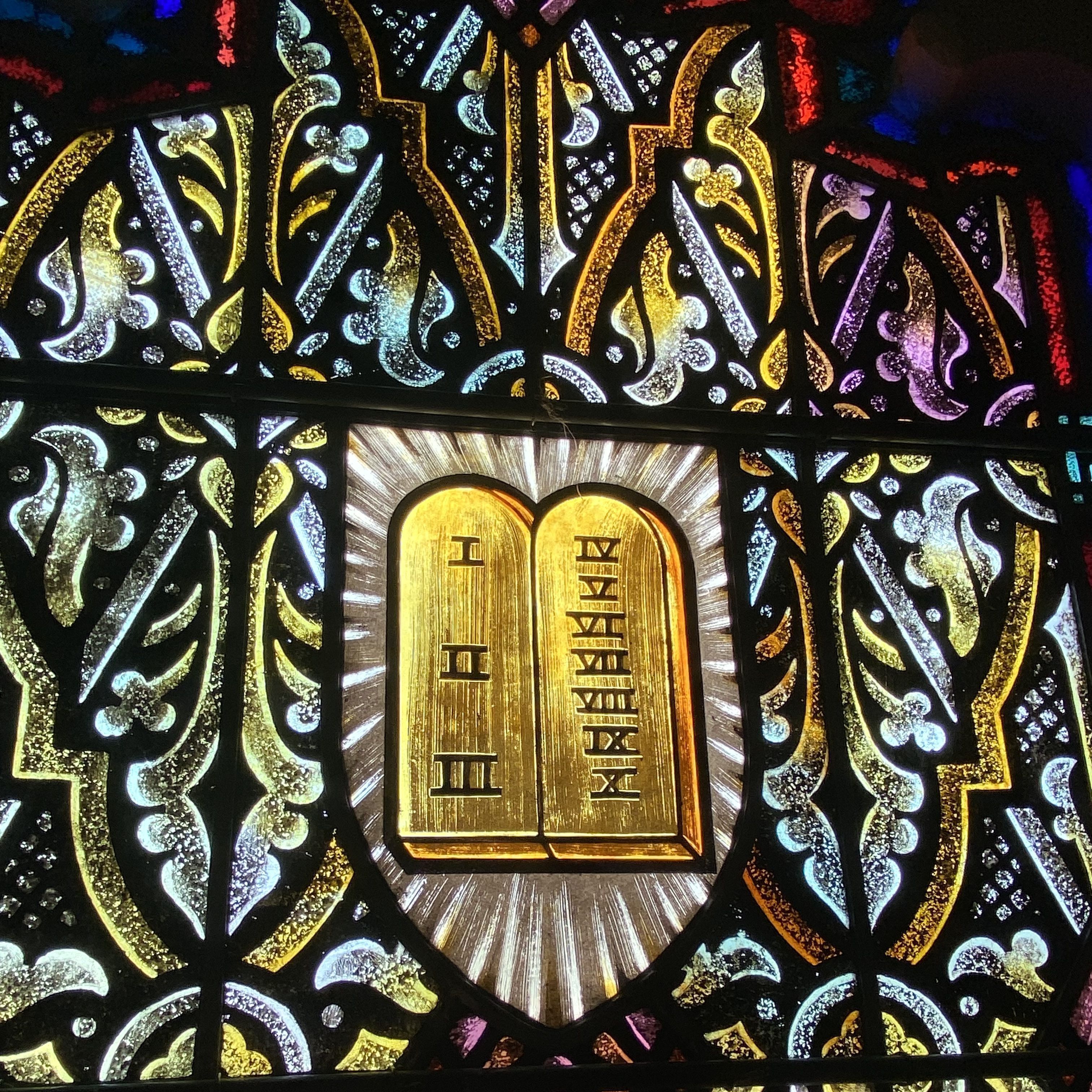
The next window to the east on the right side of the congregation has the tablets of the Ten Commandments, reminding us of Moses.
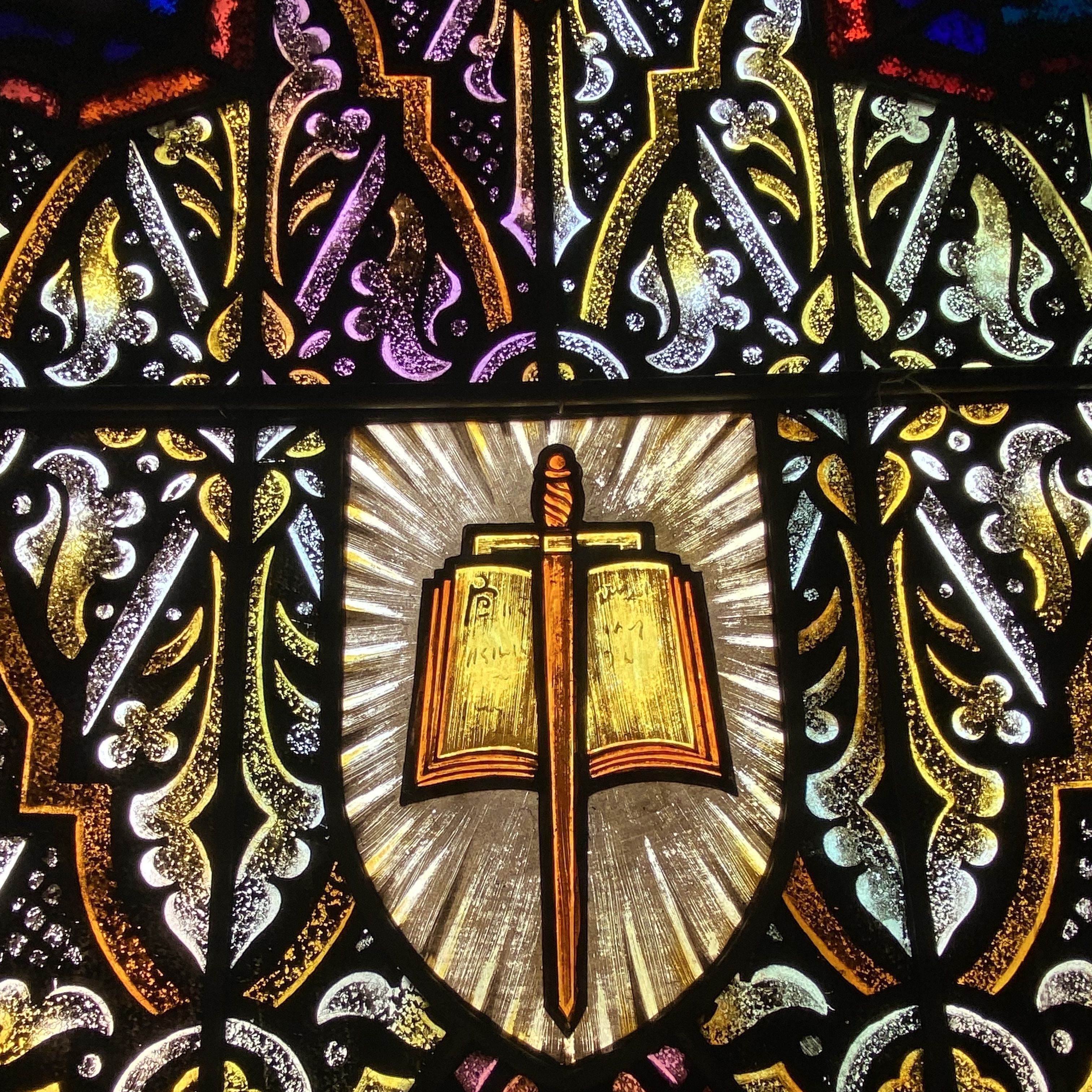
This window has the sword on the Book, representing Paul who wrote much of the New Testament and, as a Roman citizen, was beheaded with sword.
The Windows At The Front
At the left in the front of the Sanctuary (south side) are four panels dedicated to the writers of the Four Gospels: Matthew, Mark, Luke and John.
They are represented as winged creatures described in Revelation 4:7, the eagle, the ox, the man, and the lion. Each is surrounded by wings, meaning that the Gospels are to go to the end of the earth.
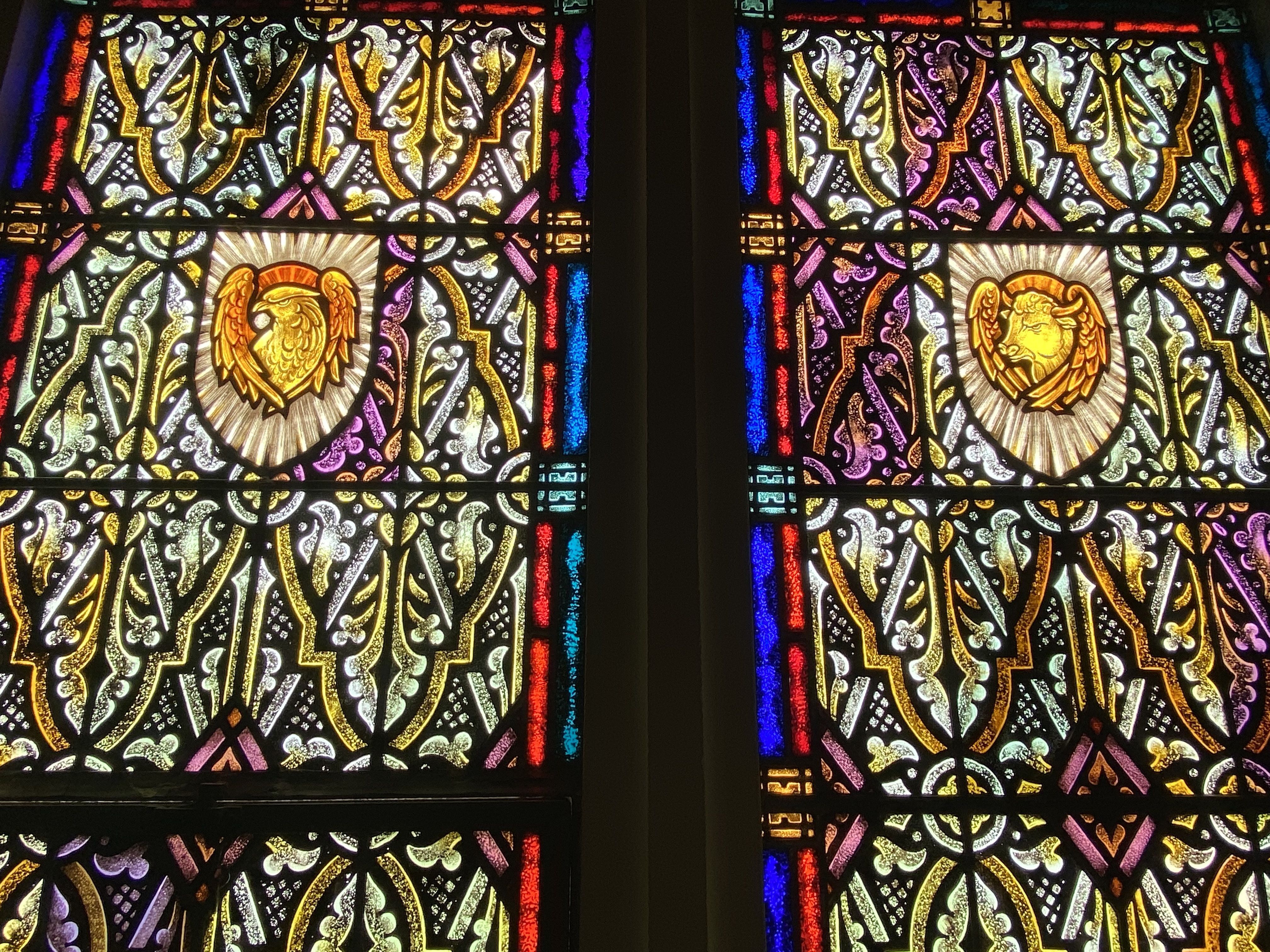
THE EAGLE -- John, who reached the highest understanding of the dual nature of Christ.
THE OX -- Luke, who writes of the priesthood and of Christ's Sacrifice.
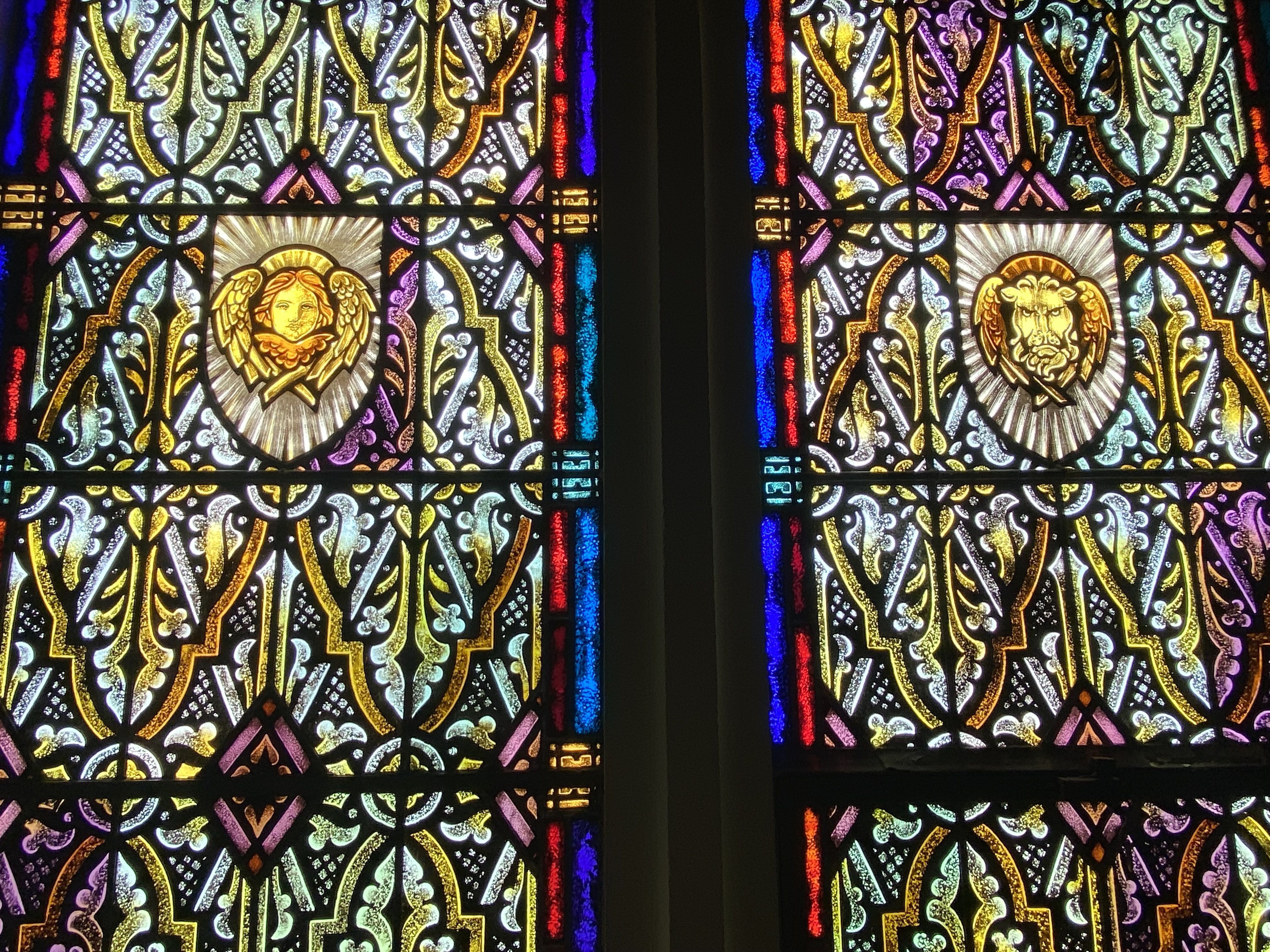
THE MAN -- Matthew, who traces the human ancestry of Christ and wrote of the Incarnation.
THE LION -- Mark, who emphasized the Kingly character of Christ.
To the right or north side, are four panels dedicated to the women of the Bible.
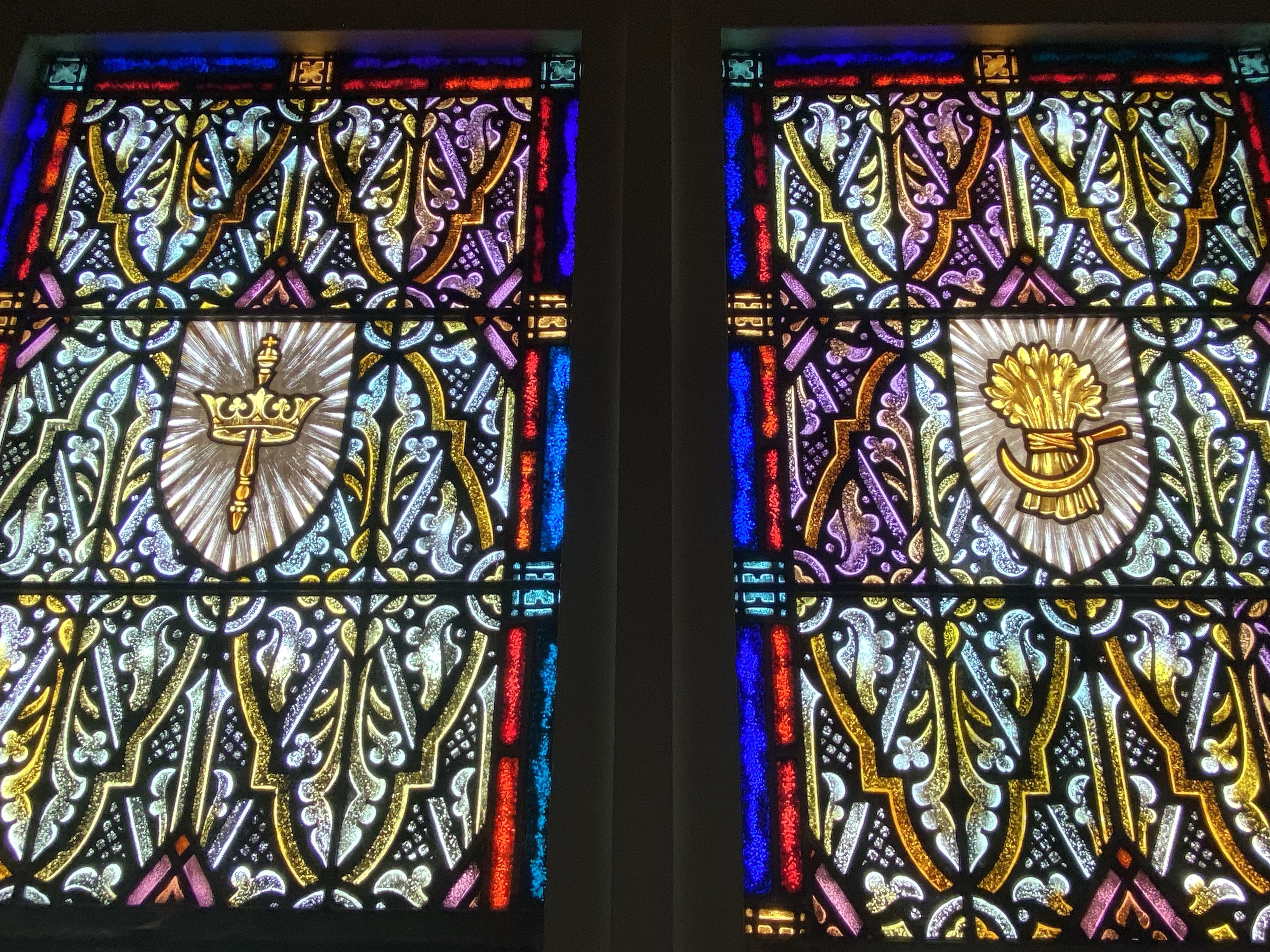
THE CROWN AND SCEPTER for Miriam -- symbols of power. She shared authority with Moses in leading the children of Isreal.
THE WHEAT AND SICKLE for Ruth -- symbols of her gleaning in the fields of Boaz.
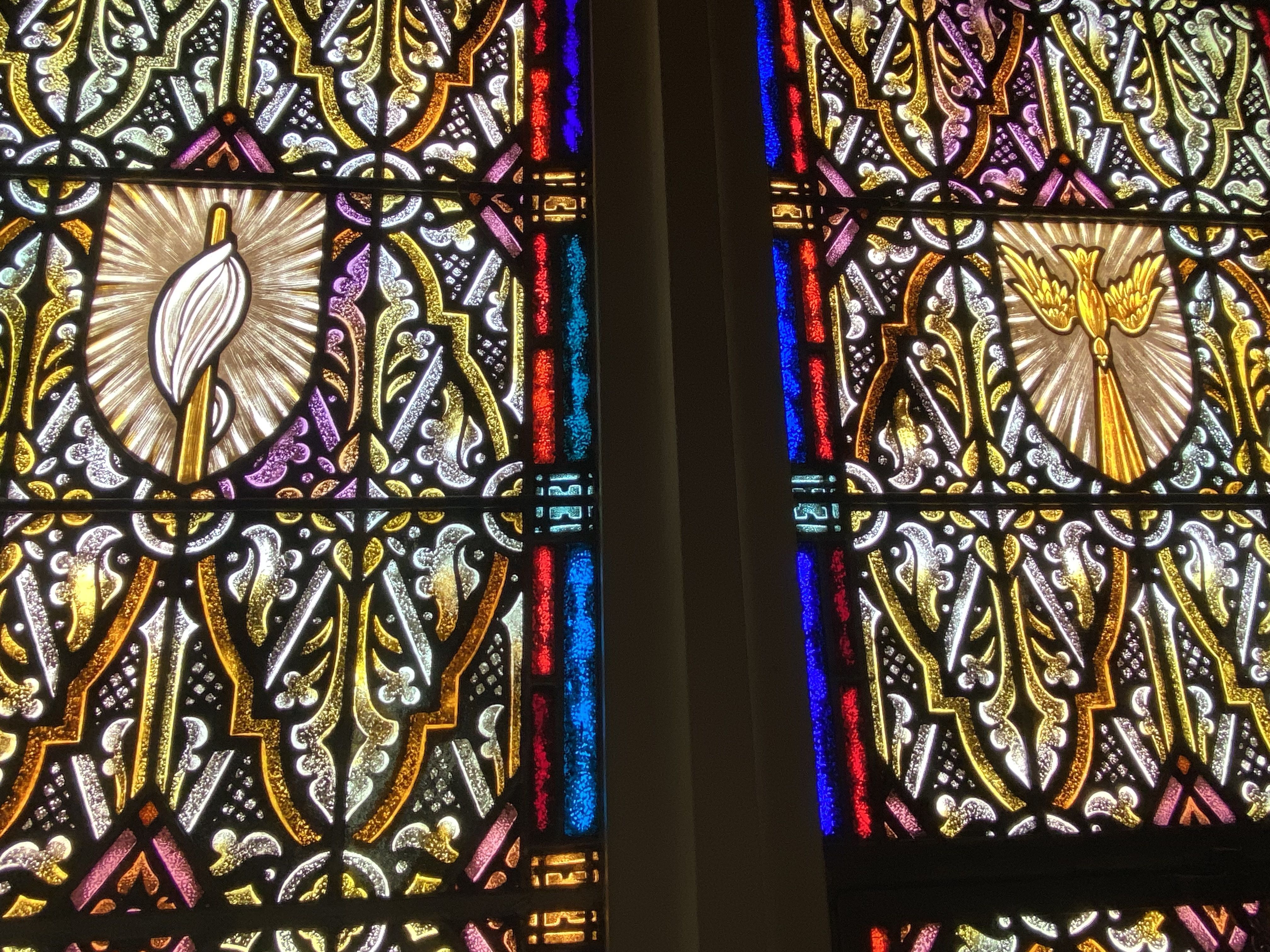
THE DISTAFF (a spindle of wool on it which was the early means of making thread) for Elizabeth, the mother of John the Baptist -- symbol of industry.
THE DOVE OF ANNUNCIATION for Mary, the mother of Jesus -- symbol of the Holy Spirit which came upon Mary at the announcement of Jesus' birth.
South Window
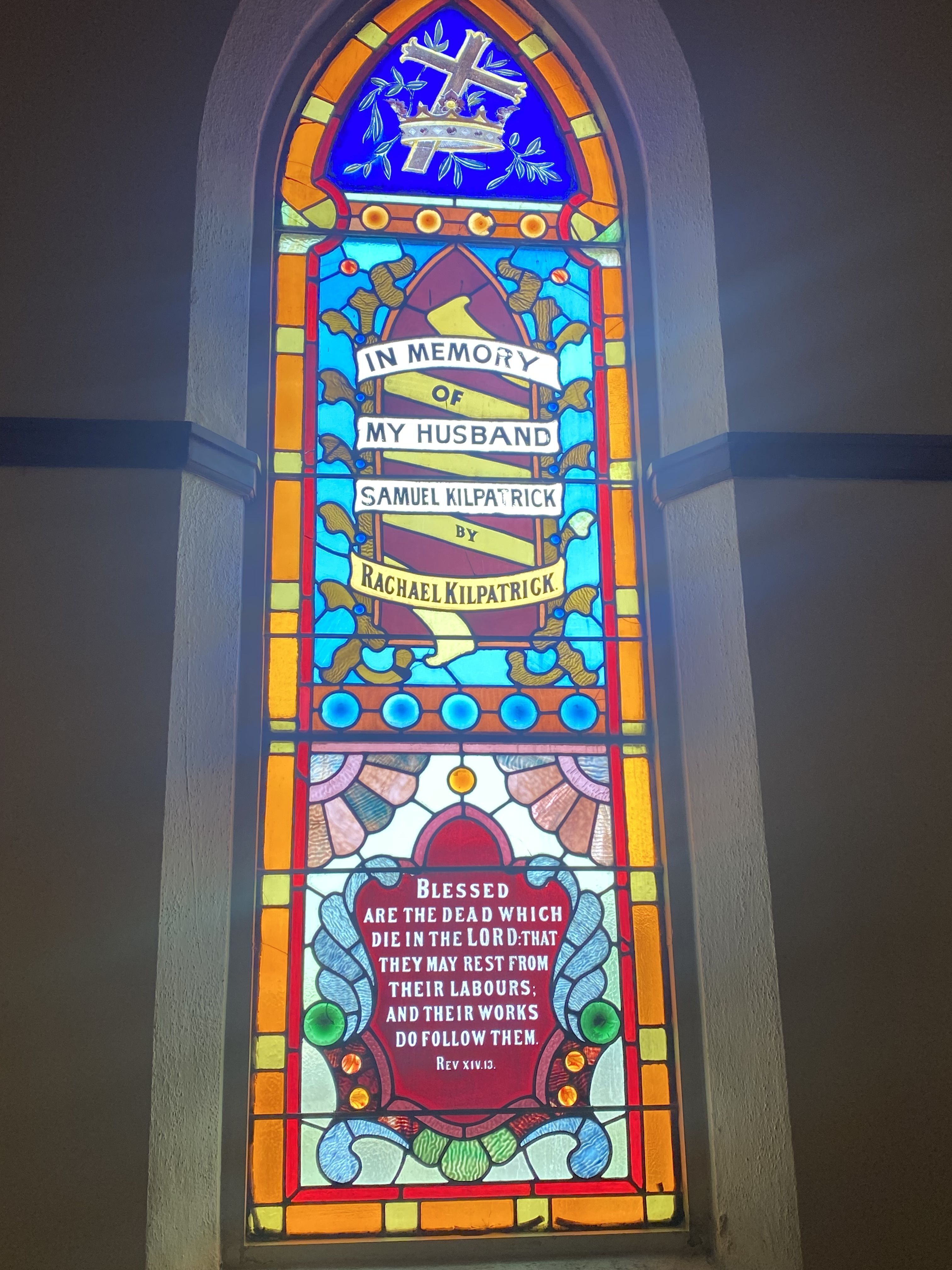
The window above the south entrance was originally in the 1884 brick church. At the top is the crown and cross which stands for the authority, royalty, power and dominion of Christ. The window also features a tribute to Samuel Kilpatrick by his wife Rachael and a quotation from Revelation.
Other Symbols
Symbols are used in many places -- on the ends of the pews, on the front of the choir loft, in the window medallions, in the tower, and even on the metal plates holding the door handles or knobs.
General symbols include; The Cross in many forms; The Book, reminding us of the message of the church; and The Shield, representing our faith.
Oak is a symbol of enduring strength. There are oak leaves found under the balcony and on the wood carving on the Altar.
Symbolic colors are used throughout the church. For instance, red represents God's love; green, immortality and life everlasting, blue, truth; purple, royalty and power.
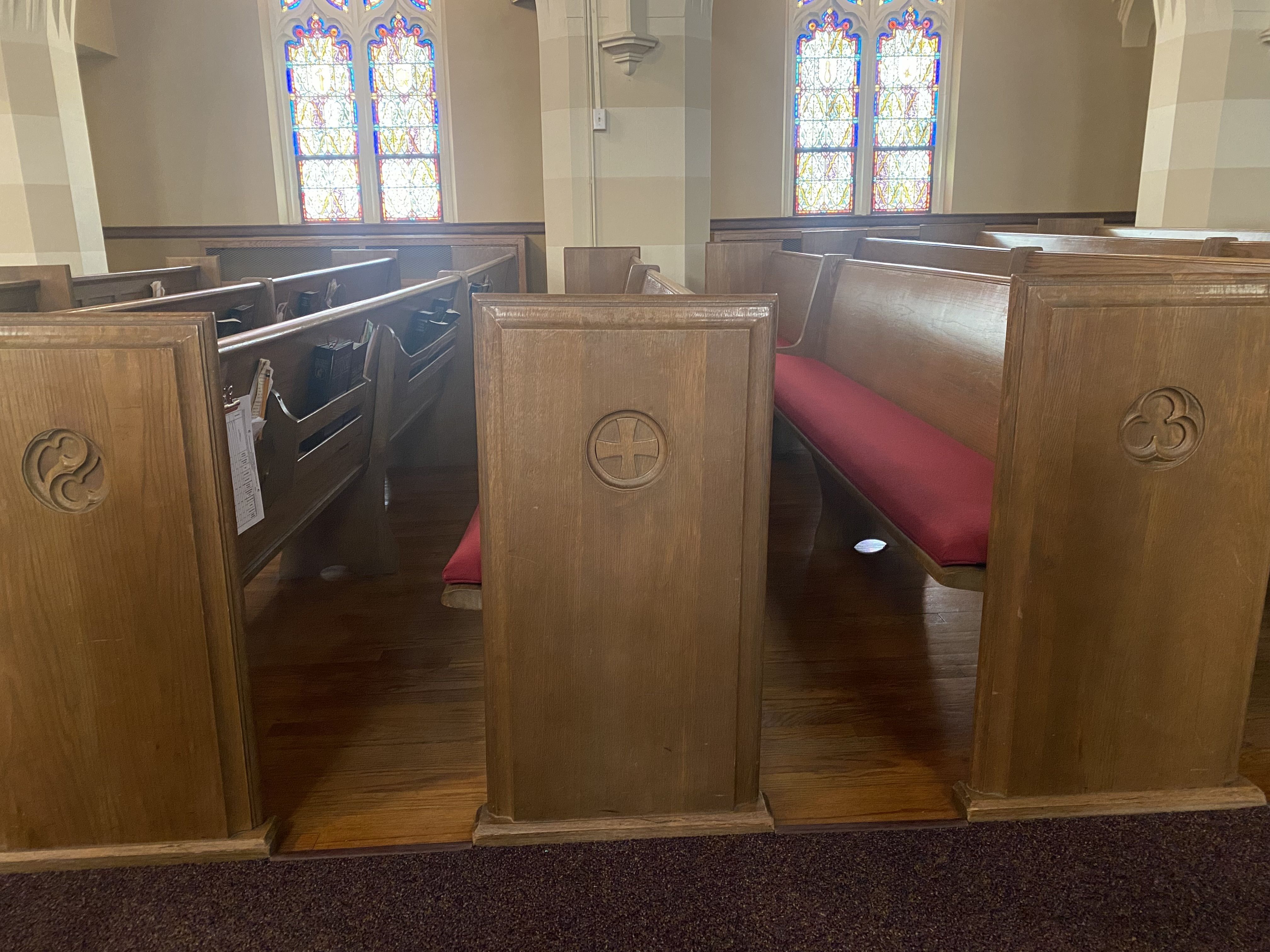
Pictured here are three symbols on the side of the pew.
VINE -- represents Christ, the True Vine, who said in John 15:5, "I am the vine, you are the branches." The vine symbol is found on the end of the pews. The vine bunches of grapes is found below the organ chambers. This symbol is also found on the ceiling beams in the west entrance and high on the walls of the activity room.
CROSS -- The cross with eight corners represents the eight Beatitudes, Matthew 5:3-10
TREFOIL -- The Trefoil, three, is the symbol of the Trinity: Fath, Son, and Holy Spirit.
NOT PICTURED;
ROSE OF SHARON -- The Rose of Sharon is used under the organ chambers. The biblical quotation is from the Song of Solomon 2:1, " I am the rose of Sharon."
STAR OF DAVID -- Two equilateral triangles from the Star of David. This is a Jewish symbol reminding us our Old Testament heritage. One can be found on the glass door going into the Sanctuary.
QUATREFOIL -- The quatrefoil, four, reminds us of the Four Gospels: Matthew, Mark, Luke, and John. Found on the end of the pews.
